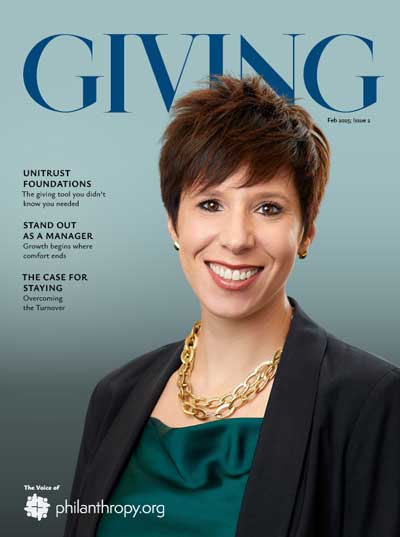Last week, I met with the board of a historic property. They had spent years preparing for a campaign to create a new education center and enlarge their endowment. Each step was carefully taken: strategic planning, building the capacity of fundraising infrastructure, strengthening governance, engaging stakeholders. Yet they were anxious. Their careful preparation set the stage for dramatic growth, just as social and economic disruptions appeared. Should they proceed in the face of such headwinds?
It seems that every few years, there’s a shock to charitable giving.
Five years ago, COVID shut down our offices, classrooms, and arts venues. Fundraising teams quickly pivoted to vigorous donor engagement, which they could implement because their time wasn’t devoted to in-person administration and meetings. American donors responded with extraordinary generosity. In the wake of obvious needs and limited opportunities for discretionary spending, 2020 and 2021 set new highs for charitable giving.
In years past, philanthropy has withstood a variety of disruptions. The Tax Cuts and Jobs Act of 2017 diminished charitable incentives and curtailed the rate of growth in giving (according to studies by Notre Dame and Indiana Universities), yet giving still eclipsed half a billion dollars by 2021. The “Great Recession” (2007-2009) saw a brief decline in charitable contributions, but the drop (2%) was slight compared to the declines in the equity markets (48%) and other economic indicators. The double-whammy of the “dot-com crash” and attacks of 9/11 taught us that donors will remain generous, as long as the causes they support continue to ask. Since 1967, giving has grown at an average rate of 6% (in current dollars) and suffered declines—often slight—only six times.
Is 2025 any different?
Since January 20, many in the nonprofit sector, including their funders and beneficiaries, have grown increasingly anxious. Executive orders imperil programs and endowments while threats to funding put some organizations’ very existence at risk. Polarization has resulted in a messaging minefield. Threatened tariffs and other economic shocks have spooked investors as the equity markets stagger.
The past has shown us that anxiety is the enemy of philanthropy.
When markets falter or social shocks occur, donors are tempted to sit on the sidelines as the storms pass. That’s bad news for nonprofit organizations that depend on contributed revenue. Typically, it has taken six to 18 months for donor confidence to rebound after an economic or political disruption. While the optimist may calculate that a routine giving environment will emerge yet this year, and a pessimist abandons hope and delays action, a realist will take steps now to resist declines—and even thrive. How?

1. Project Resilience
Your organization has weathered past storms and emerged stronger. The current environment may necessitate decisions that will be painful for your co-workers or clients. Nevertheless, your mission will persist. Continue to center your mission and its impact in all messages and actions. You may need to use different words—to resonate with stakeholders and avoid conflict—but you can still do the work. Find additional guidance on specific messaging tactics in, “Fundraising in the Age of Disruption: Communicating with Conviction and Courage,” written by our communications team.
2. Sustain Relationships
“Change isn’t built on hostility,” Jennifer Sirangelo, President and CEO at Points of Light, observed recently “…step away from the internet and connect with people in real life.” Unlike the COVID days when calendars were suddenly wide open and outreach was a welcome task, you may feel that additional outreach is just one more burden on your too-long “to do” list. Instead of adding tasks, consider all of the ways you already engage stakeholders, and use those opportunities to provide reassurance and restate your mission. Be sure to have an inventory of stories that will illustrate your ongoing impact in a way that will resonate
3. Don’t react. Respond.
When news cycles are filled with inaccuracies or opposing viewpoints that create misperceptions, it is tempting to urgently declare what you are not. While refuting misinformation might be satisfying, it probably isn’t strategic. Instead, focus all messages and actions on the best of what you are.
4. Adopt donor-centric solicitation strategies.
This might not be the time to ask a donor for a five-year pledge to fulfill a $1 million gift to realize her dream of an endowed scholarship. Instead, consider asking the donor to give $200,000 now, and promise to revisit the situation in a year when the forecast will (hopefully) be clearer. For other examples of donor-centric giving strategies, consider some of the methods we discussed in, “14 Tactics for an Uncertain 2025.”
In many ways, the current environment does feel different than those earlier disruptions. We can still apply the lessons learned in the past, and gain new insights to make our causes even more resilient for the future.
What did I suggest to the leaders of the historic site? You can probably guess by now:
Don’t make pre-emptive decisions for your donors or your community. You may find that the going is tough in the beginning. You may find that donors need to express their anxiety before they’re willing to learn about your aspirations. Every campaign experiences a variety of economic, social, and political situations over multiple years of fundraising. By starting now, you’ll be poised to soar when conditions improve and your peers—who lacked confidence—are just getting started. Stay the course.







